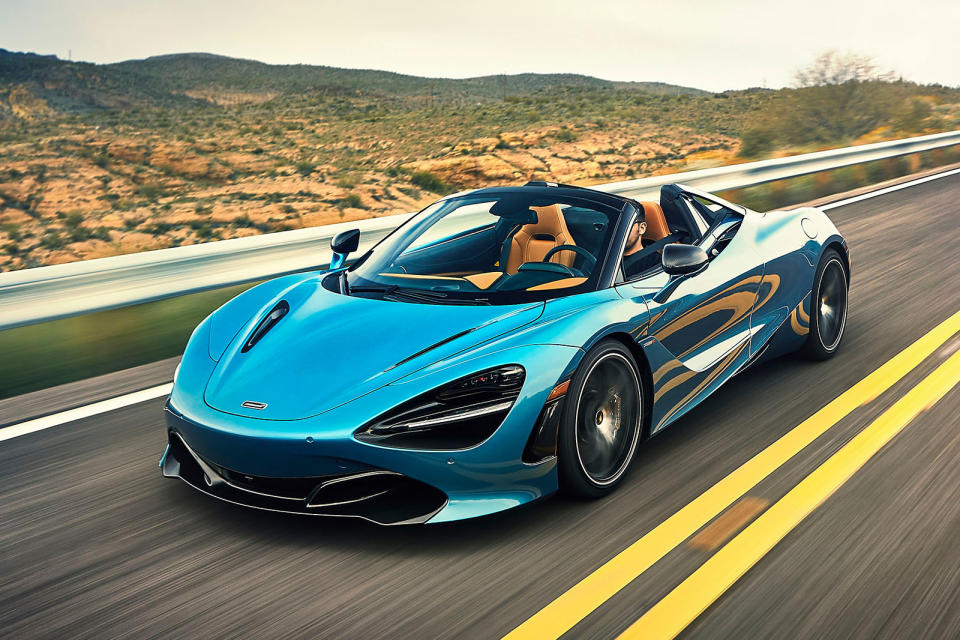McLaren 720S Spider

Almost two years after its launch, the McLaren 720S remains the best supercar in the world – some achievement from a company that still hasn't even been making cars for a decade.
Even in McLaren's earlier days, when it wasn’t quite on top of the world, it made a darn good convertible supercar with its 650S Spider, and the 12C Spider before it.
The strength of McLaren’s carbonfibre tub meant a conversion from coupé to convertible could be made without sacrificing stiffness and adding little weight, thus avoiding the main pitfalls that have nearly always historically made a convertible supercar a slower, heavier and worse-looking version of the coupé from which it's derived.
Now the 720S Spider has arrived to carry on that rich open-top bloodline. Its official brief is to be the ‘most complete convertible supercar’, and if it’s as good as its credentials suggest, it should be the more desirable version of the world’s best supercar, and the one you’d probably buy. The de facto world’s best supercar, even.
How does the Spider differ from the standard 720S?
Those credentials, then. McLaren’s carbonfibre Monocage II structure has been adapted to now be called Monocage II-S. That essentially means the coupé’s dramatic dihedral doors have been lost due to the fact a retractable one-piece hard-top roof needs to be added, but, in doing so, all of the structural strength has been retained. No fixed roof means the addition of a new rollover protection system, bonded to the chassis, made from carbonfibre and 6.8kg lighter than the 650S Spider’s steel construction.
While we’re talking weight, the 720S Spider weighs just 1332kg dry, which is lighter than the current class featherweight, the 1420kg Ferrari 488 Spider, and just 49kg heavier than the coupé. Dry, the old 650S Spider weighed 1370kg, which goes to show that McLaren has long known how to make a stiff and light convertible supercar.
Key components, such as the 710bhp twin-turbocharged 4.0-litre V8 petrol engine and the advanced hydraulic Proactive Chassis Control suspension set-up, make it over from the coupé, with the two cars sharing a 0-62mph time of 2.9sec and a top speed in excess of 200mph. In fact, the Spider can hit 202mph even with its roof down.
How does the 720S Spider perform on the road?
Whether or not you’d actually want to do 202mph with the roof down is another matter, but, due to the quite extraordinary force at which the 720S Spider accelerates, you’ve little doubt it’d get you there. This is one seriously quick car, both off the line and while accelerating in gear; another quite remarkable stat is its 0-124mph time of just 7.9sec, which is only 0.1sec shy of the coupé's. This is no poor relation in the performance stakes, and you’re only made to pay for the marginal weight gain when you’re long past speeds at which you’d have your licence confiscated anyway.
The gearbox is wonderfully integrated, shifting quicker the higher up the rev range you go, and just as competent in operation whether you're using the paddle shifters or simply leaving it to its own devices.
The one area in which this powertrain falls down is noise, with the twin-turbo V8 lacking any real aural soul and surprisingly quite droney even in top gear on a motorway cruise. You’re not exactly encouraged to have the glass rear screen pulled down to fill the interior with engine noise.
One thing the 720S Spider is very good at is cruising. The ride is very comfortable for such a potent supercar – the kind you can cover big distances in and still feel ready for more. That shouldn’t really be a surprise in a McLaren anymore, yet you’re still taken aback by how sophisticated it all is.
Where McLaren really broke new ground with the 720S over the 12C and 650S before it was how it married that ride sophistication with new-found handling verve, excitement and dynamism. And we're happy to report that's something else carried over from the coupé to the Spider; the car is fast, fun and involving but also approachable.
Whereas many a supercar is intimidating, the 720S Spider encourages you to go faster and find your limits. It displays wonderful poise and urgency, the chassis and powertrain working in harmony and all controlled through the throttle. The steering is also beautifully weighted, with real accuracy and feel.
You can also marvel at the 720S Spider’s improved usability over the 650S Spider as a convertible. The roof opens and closes faster, in just 11sec, a 6sec improvement, and while the car is doing speeds of up to 31mph, instead of 18mph. Both front and rear visibility are better, too, the latter due to the lower rear deck and glazed buttresses. There’s also an optional glass roof that turns opaque to almost transparent at the touch of a button, flooding the interior with light in the process.
In practically every department, the 720S Spider has lost nothing over, and is the dynamic equal of, the coupé from which it's derived, and it has gained extra desirability in the process. McLaren is on the very top of its game at the moment.
]]>

 Yahoo Autos
Yahoo Autos 
